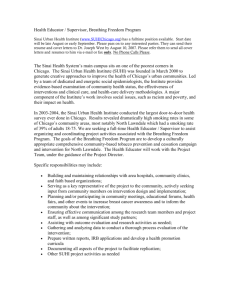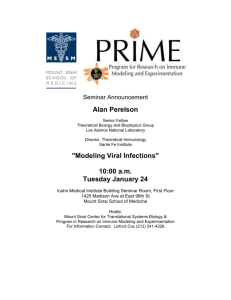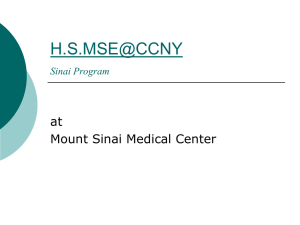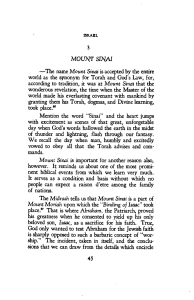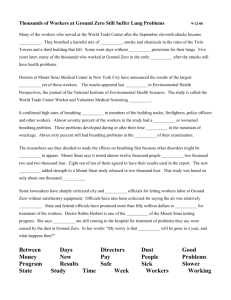Community Health Needs Assessment Holy Cross Hospital June
advertisement
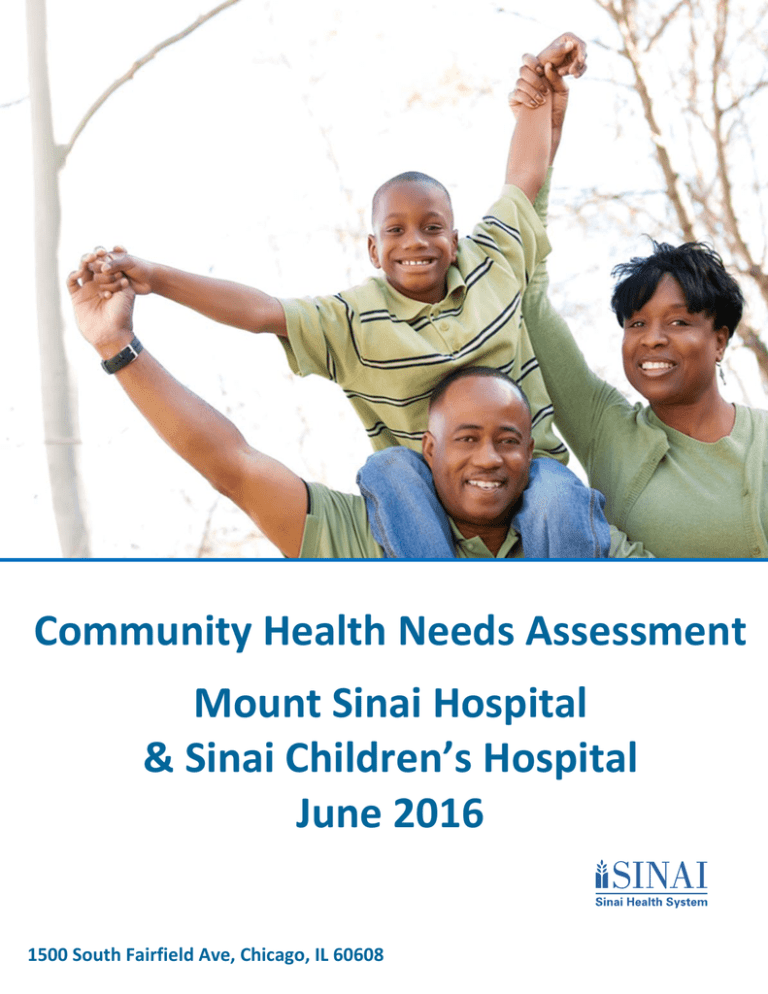
Community Health Needs Assessment Holy Cross Hospital June 2016 Community Health Needs Assessment Mount Sinai Hospital & Sinai Children’s Hospital June 2016 1500 South Fairfield Ave, Chicago, IL 60608 About Us Located on the West and Southwest sides of Chicago, Sinai Health System is comprised of Mount Sinai Hospital, Holy Cross Hospital, Sinai Children’s Hospital, Schwab Rehabilitation Hospital, Sinai Medical Group, Sinai Community Institute, and Sinai Urban Health Institute. The member institutions of Sinai Health System collectively deliver a full range of high-quality outpatient and inpatient services, as well as a large number of innovative community-based health, research, and social service programs. We focus our collective depth of expertise and passion to improve the health of the 1.5 million people who live in our diverse service area. Sinai Health System, with our team of dedicated caregivers, is uniquely committed to building stronger, healthier communities. Mission Our mission is to improve the health of the individuals and communities we serve. For more information about us, please visit our website: http://www.sinai.org/ |2 Making Lives Better It’s our promise to the community The mission of Sinai Health System is to improve the health of the individuals and communities we serve. To better meet our mission, this Community Health Needs Assessment has been produced to provide an overview of the health status of our communities. Produced by the Sinai Urban Health Institute, in collaboration with a diverse set of stakeholders, this assessment provides an overview of social and public health data that describe not only the communities we serve, but also how those communities compare to the broader Chicago area population. Each measure provides important information for developing the tactics necessary to improve the communities’ overall health. Sinai Health System would like to recognize all those who made this assessment possible. Thank you for letting us be your community partner. |3 Table of Contents Introduction……………………………………………………………………….…………….....…….5 Sinai System Overview…………………...............................................................6 Mount Sinai Hospital Communities………………………………………………….…………8 Mount Sinai Hospital Community Benefits ..…………………………………….…….…8 CHNA Process and Methodology……………………………………………….……………...9 The Communities We Serve………….............................................................11 Community Health Profile…………………........................................................16 Mortality………………….........................................................................17 Hospitalizations and ED Admissions…………….....................................20 Birth Outcomes…………………...............................................................26 Community Input…………………......................................................................30 2016 Priorities…………………………………..…………..………………………….………….…..33 |4 Introduction As part of the Affordable Care Act (ACA) of 2010, each hospital facility in the U. S. must conduct a Community Health Needs Assessment (CHNA). This very important aspect of the ACA mandates that hospitals must assess the health of the communities they serve, not just the patients who walk into their buildings, and that they must make a plan to improve community health. This report brings together epidemiological data and the input of our community members to describe health needs and assets of the communities Mount Sinai Hospital serves. Together, the data findings and community input helped us determine the most important health issues to address as a hospital and as a health system. This CHNA is part of our continual process to not only understand the health-related needs of the communities we serve, but to work with our community members and partners to develop and implement creative strategies to address these needs. The real goal of conducting a CHNA is to use it to motivate and guide actual changes. Mount Sinai Hospital has a long history of striving to improve the health of the poor communities on the West side of Chicago. This assessment and corresponding plan of action provide an ideal blueprint from which Mount Sinai Hospital can continue to improve community health through changes inside and outside our walls. Here we present, with pleasure, the 2016 CHNA for Mount Sinai Hospital, which includes Sinai Children’s Hospital. CHNAs for Schwab Rehabilitation Hospital and Holy Cross Hospital can be found on our website, www.sinai.org. “Of all the forms of inequality, injustice in health care is the most shocking and inhumane.” Dr. Martin Luther King, Jr., 1966 This report is consistent with the mission and vision of our health system and also with the language and spirit of the new federal regulations requiring such assessments. We hope that this assessment, like the previous ones we have done, will provide a roadmap to improved health for communities on the West and Southwest sides of Chicago. We believe this report is critical not only for guiding the actions of our health system, but also that it may be a valuable resource for members of our community and the organizations which serve them. It is in this spirit that we share this CHNA with the reader. |5 Sinai Health System Overview The Sinai Health System (SHS) is a unique health care delivery system on the West and Southwest sides of Chicago. Mount Sinai Hospital (MSH) was founded in 1919 to provide care to Eastern European Jewish immigrants in the area, as well as to create a place for Jewish doctors to practice. We now serve predominantly African-American and Latino communities, but our mission has remained the same. This mission addresses our desire to make a difference in both the individuals and the communities we serve. As we develop innovative and effective ways to do this, we strive to become the national model for the delivery of urban healthcare. Along with MSH and Sinai Children’s Hospital (SCH), our system includes Holy Cross Hospital (HCH), Schwab Rehabilitation Hospital (SRH), Sinai Medical Group (SMG), the Sinai Community Institute (SCI), and the Sinai Urban Health Institute (SUHI). Below are descriptions of these entities. Mount Sinai Hospital (MSH) is a 319-bed teaching hospital with a Level 1 Trauma Center, 60,000 emergency visits, and 4,000 deliveries per year. MSH is a communitybased hospital that provides exceptional medical, surgical, behavioral health, therapeutic, and diagnostic services. MSH also trains more than 700 health care professionals a year. Sinai Children’s Hospital (SCH) includes pediatric cardiology, gastroenterology, nephrology, allergy, endocrinology, urology, physical medicine and rehabilitation, and neurology services. In 2010, there were 2,280 admissions to SCH. SCH has a Level III Neonatal Intensive Care Unit Center, which is the highest level of care for fragile newborns, and a Pediatric Intensive Care Unit. |6 Holy Cross Hospital (HCH) is a 274-bed Catholic community hospital on the southwest side of Chicago, offering intensive care, medical and surgical services, as well as obstetrics, rehabilitation, hospice, and an array of diagnostic and therapeutic services. Its Emergency Department receives 50,000 visits per year, and more ambulance runs than any hospital in the state, a function of the hospital’s geographic isolation and local unaddressed health needs. Schwab Rehabilitation Hospital (SRH) was the first accredited rehabilitation hospital in the Midwest. Today it serves as a regional 102-bed rehabilitation center with innovative therapies including music and horticulture. It is the only rehabilitation facility in the Chicago area accredited by both the Joint Commission and CARF in the disease-specific area of stroke. Sinai Medical Group (SMG) includes 295 physicians with 39 medical and surgical specialties who work at Mount Sinai Hospital and other Sinai Health System sites throughout the Chicago area. Sinai Community Institute (SCI) provides education, employment counseling, case management, and nutrition services that address the social and economic factors affecting the health of the community’s most vulnerable members—infants, children, adolescents and older adults. Of the 30,000 annual client visits, approximately 98% are for low-income minority women and children. Sinai Urban Health Institute (SUHI) is a leading research center, focused on eliminating health disparities through social epidemiology, program evaluation, health interventions, teaching and consulting. SUHI is currently implementing a wide range of health interventions within the community to address issues such as pediatric asthma, breast cancer screening, and diabetes. |7 Mount Sinai Hospital Communities The MSH primary service area includes the following Chicago community areas: Archer Heights Brighton Park Chicago Lawn East Garfield Park Gage Park Humboldt Park Lower West Side Near West Side North Lawndale, South Lawndale West Elsdon West Garfield Park West Lawn A description of the demographic and socioeconomic characteristics of individuals living in these communities is provided in the next section. Mount Sinai Hospital Community Benefits In 2015, MSH provided $32 million in community benefits, including charity care, subsidized health services, language assistance, education, research donations, coverage for bad debts, and volunteer services. Breaking this number down, charity care comprised $16.9 million of that $32 million and other community benefits added up to another $15 million. These benefits provide funding for many unfunded community initiatives that promote health, healing, or treatments. |8 CHNA Methodology & Process To best understand the health of our community, we have assembled data from a variety of quantitative and qualitative sources. More specifically, this report includes data from vital records, birth and death certificates, and hospital data. These data sources provide us with a snap shot of the communities’ health in terms of morbidity and mortality. We have attempted to interpret the findings in order to make them more accessible to everyone in the community. In addition to this extensive quantitative data, we also solicited input and feedback from community members, stakeholders, and community-based organizations through interviews and focus groups. The knowledge gathered from community members in this way helps provide context for the quantitative data. When combined, the overall report offers a great deal of information to help guide our health system’s priorities and the efforts of other communitybased organizations. The CHNA begins by describing the communities we serve. Next, we examine prominent causes of death and illness in these communities, leading reasons for hospital admissions and readmissions. We then present discussions of birth outcomes, child, and adolescent health. These data are followed by community input, obtained through focus groups and interviews with members of the communities we serve. We then discuss community assets that aid in health improvements. Finally, we present our priority health areas, which are based on both the quantitative and qualitative data. |9 The Mount Sinai Hospital Community Health Needs Assessment was conducted through the following process: Data Collection & Analysis • Gather demographic and epidemiologic data Community Engagement • Conduct focus groups and key informant interviews Synthesis of Inputs • Analyze qualitative and quantitative data Prioritization of Health Needs • Adults: Chronic Disease, Mental & Behavioral Health, and Violence • Children: Asthma, Behavioral Health, and Birth Outcomes Action Plan Development • Create a plan to address health prorities over the next three years Implementation: Making Lives Better • Implement Action Plan in partnership with the community | 10 The Communities We Serve Throughout the remainder of this document, Mount Sinai Hospital, which includes Sinai Children’s Hospital, will be referred to as MSH. The MSH primary service area (PSA) is comprised of thirteen communities on the west side of Chicago, where 80% of our patients reside (Figure 1). The map belows outlines MSH’s PSA and displays MSH and other hospitals and clinics in the area. Figure 1. The Mount Sinai Hospital Primary Service Area, Corresponding Community Areas, and Health Resources Mount Sinai Hospital Communities 1 9 2 12 10 0 76 77 13 11 4 14 3 0 16 15 Archer Heights (57) 5 17 6 21 Brighton Park (58) 18 19 20 Chicago Lawn (66) 22 7 24 23 25 East Garfield Park (27) 26 Gage Park (63) 8 v® 27 v® v® v®v®28 v® v® 29 v® 31 32 " u Humboldt Park (23) 30 33 34 60 Lower West Side (31) 35 59 36 58 Near West Side (28) 57 56 North Lawndale (29) 62 63 65 66 64 South Lawndale (30) West Elsdon (62) 37 61 v® 38 39 41 40 42 68 67 69 70 71 43 45 44 West Garfield Park (26) 47 72 West Lawn (65) " u 49 v® Mount Sinai Hospital (MSH) Hospitals 48 73 MSH PSA 74 46 52 50 0 51 75 53 55 54 Clinics Esri, HERE, DeLorme, USGS, Intermap, increment P Chicago community Area Sources: Corp., NRCAN, Esri Japan, METI, Esri China (Hong Kong), Esri (Thailand), MapmyIndia, © OpenStreetMap contributors, and the GIS User Community | 11 The communities we serve are young, economically challenged, and primarily Black and Hispanic. Age Distribution The communities in the MSH PSA are young. Twelve of the 13 communities have a greater proportion of children than the Chicago average (23%). Twelve of the 13 communities MSH serves also have a lower proportion of people over the age of 65 than the city of Chicago (10%). This age distribution is due in part to having higher birth rates and lower life expectancies than the city as a whole. Race and Ethnicity Twelve of the 13 communities in the MSH PSA have minority populations exceeding 75%. Three of these communities are mostly Black, 7 are mostly Hispanic, and 2 are approximately half Black and half Hispanic (Figure 2). Figure 2. Racial and Ethnic Distribution by Community Area | 12 Median Household Income The communities within the MSH PSA are economically challenged. All but two of the communities served by MSH have median household incomes less than the Chicago average (Figure 3). The median household income for North Lawndale is roughly half of the city median income. Figure 3. Median Household Income by Community Area Individuals Living in Poverty In the communities served by MSH, the percentage living below the poverty line ranges from 14% to 45%. Ten of the 13 communities have a poverty rate higher than the Chicago average (Figure 4). Three communities (East Garfield Park, North Lawndale, and West Garfield Park) have a poverty rate two times higher than the city average. Figure 4. Percent Living in Poverty by Community Area | 13 Unemployment Thirteen percent of Chicagoans age 16 and over are unemployed (Figure 5). All but one of the communities within MSH’s PSA have a higher unemployment rate than the city overall. West Garfield Park’s unemployment rate is double that of Chicago’s. Figure 5. Percentage of Adults 16 and Over Who are Unemployed Educational Attainment Nineteen percent of Chicago adults over age 25 do not have a high school diploma (Figure 6). In 12 of the 13 communities, the percentage of adults without a high school diploma is higher than that for the city. In two communities (Gage Park and South Lawndale), over half of adults lack a high school diploma. Figure 6. Percentage of Adults 25 and Over Without a High School Diploma | 14 Crowded Housing Crowded housing is defined as a housing unit with more than one person per room. Five percent of Chicagoans live in crowded housing conditions. In 12 of the 13 communities in the MSH PSA, the percentage of individuals living in crowded housing is higher than the city average (Figure 7). Three communities (Gage Park, Humboldt Park, and South Lawndale) have a crowded housing rate three times higher than the Chicago average. Figure 7. Percent living in overcrowded housing conditions Hardship Index The Hardship Index is a socioeconomic disadvantage score, based on housing, poverty, employment, educational attainment, and age indicators. Each Community Area receives a score ranging from 1 to 100 with 100 being the greatest hardship. Nine of the 13 communities in the MSH PSA have Hardship Index scores between 75 and 100 (Figure 8). South Lawndale, Gage Park, and West Garfield Park have some of the highest levels of hardship in the city. Figure 8. Hardship Index Scores by Community Area | 15 Community Health Profile What we die from and how old we are when we die tell us a lot about our health and how to go about improving it. The following is an examination of life expectancy and mortality data for the city of Chicago and the thirteen communities in the MSH PSA. Life expectancy is the number of years a person can expect to live at the time of birth. Mortality data tell us what people are dying from. Life Expectancy Life expectancy varies substantially across Chicago and across the communities we serve. Differences in life expectancy are one of the clearest examples of racial and income inequalities. The two communities with the lowest life expectancies, East and West Garfield Park, are over 90% Black and have some of the lowest median incomes of the 13 communities in our Primary Service Area People living in West Garfield Park can expect to die 9 years sooner than the average Chicagoan. Figure 9. Life Expectancy by Community Area How does place influence health and life expectancy? Where a person lives affects health outcomes such as life expectancy. For instance, affordable healthy foods and a safe place to exercise are not always available in every Chicago community. People who can access healthy foods and exercise are more likely to lead a healthy lifestyle and thus live longer. In addition to poverty, other societal factors such as racism, low education, and pollution also impact health. It follows then that how many people die and what people die from varies from community to community. | 16 Top Causes of Death Heart Disease Heart disease is the leading cause of death in the U.S. and in Chicago. Heart disease mainly affects older people and occurs when the heart and blood vessels are not working the way they should. The citywide heart disease mortality rate is 146 deaths per 100,000 people. Six of the 13 communities in the MHS PSA have heart disease mortality rates higher than the city rate (Figure 10). These 6 communities are primarily Black communities on the West and Southwest sides of the city. Figure 10. Heart Disease Mortality Rate per 100,000 (2006-2010) Cancer Cancer is the second leading cause of death in the U.S. and in Chicago. While the overall cancer death rate has declined and the number of survivors has increased, large disparities still exist between racial and ethnic groups, cities, and communities, with Black men suffering the highest cancer mortality rates. Cancer is a leading cause of death for all 13 communities in the MSH PSA, but even within our PSA there are large differences. West Garfield Park’s cancer mortality rate is double that of the rate for Lower West Side, Brighton Park, and South Lawndale (Figure 11). Figure 11. Cancer Mortality Rates (2006-2010) | 17 Of all the cancers, Lung and Prostate, are the top two cancers that cause death in the communities served by MSH. Lung cancer mortality rates are substantially higher for North Lawndale and West Garfield Park than the city as a whole, and over twice as high as the rates for Lower West Side and South Lawndale (Figure 12). Figure 12. Lung Cancer Mortality Rates (2006-2010) The citywide mortality rate for prostate cancer is 33 per 100,000, more than three times the national rate. West Garfield Park’s prostate cancer mortality rate is nearly triple the citywide mortality rate, and nearly ten times higher than the national rate (Figure 13). Figure 13. Prostate Cancer Mortality Rates (2006-2010) | 18 Stroke Stroke is the fifth leading cause of death in the U.S. and the fourth leading cause of death in Chicago. Similar to a heart attack, a stroke can result when a blood vessel is damaged or blocked, denying oxygen-rich blood to the brain. The risk factors for stroke, including unhealthy lifestyle factors and conditions such as high blood pressure, may be modified or prevented. The citywide stroke mortality rate is 43 per 100,000. Six of the 13 communities in the MSH PSA have stroke mortality rates higher than the city rate. Stroke mortality is particularly high in West Garfield Park and North Lawndale (Figure 14). Figure 14. Stroke Disease Mortality Rate (2006-2010) Homicide While homicide is not one of the top causes of death in the U.S. or Chicago, the communities surrounding MSH are disproportionately plagued by violence, which unfortunately often results in death. Homicide mortality disparities are particularly evident in some of our communities. West Garfield Park and North Lawndale have homicide mortality rates three times higher than the city (Figure 15). Figure 15. Homicide Mortality Rate (2006-2010) | 19 Hospitalization and Emergency Department (ED) Admissions Like information about what people die from, hospitalization and Emergency Department (ED) admissions data help us understand the burden of specific diseases and conditions for different groups of people. This data is available by zip code rather than community area. We present here several of the top hospitalization and ED admissions for the MSH PSA, which includes 6 zip codes (60608, 60612, 60623, 60624, 60629, and 60632). Adult Asthma Hospitalization and ED Admissions Asthma is one of the leading causes of hospitalization in the MSH PSA and is also considered an ambulatory care sensitive condition (ACSC), which means it is potentially preventable with proper outpatient care. Within the 6 MSH PSA zip codes, 60624 and 60612 have the highest burden of asthma ED admissions and hospitalizations (Figure 16). The ED admissions rate for zip code 60624 was 5 times higher than the rate for the city overall (Figure 17). Figure 16. Adult Asthma Hospitalization Rate Figure 17. Adult Asthma ED Admissions Rate Chronic Obstructive Pulmonary Disease (COPD) Hospitalization and ED Admissions COPD is a lung disease characterized by chronic obstruction of lung airflow that interferes with normal breathing. COPD is a major cause of death and illness in the U.S. It presents exacerbations that often lead to ED and hospital admissions. Chicago as a whole has lower rates than the nation for COPD hospitalization and ED admission. Within the MSH PSA, zip code | 20 60624 has the highest rates of COPD hospitalization (Figure 18) and ED admissions – more than double the city rates (Figure 19). Figure 18. Adult COPD Hospitalization Rate Figure 19. Adult COPD ED Admissions Rate Adult Heart Disease Hospitalization and ED Admissions There are substantial disparities within the MSH PSA for heart disease hospitalization and ED admissions. Zip code 60624 has a heart disease hospitalization rate (Figure 20) that is more than double that of zip code 60632, and has triple the heart disease ED admissions rate of 60632 (Figure 21). Figure 20. Adult Heart Disease Hospitalization Rate Figure 21. Adult Heart Disease ED Admissions Rate | 21 Adult Diabetes Hospitalization and ED Admissions Five of the 6 zip codes in the MSH PSA have diabetes hospitalization and ED admission rates higher than city and national averages. Zip code 60624, the area roughly corresponding with the East and West Garfield Park and North Lawndale communities, has a diabetes hospitalization (Figure 22) and ED admission rate (Figure 23) more than twice as high as the city average. This indicates that many people experience uncontrolled diabetes, which puts them at a higher risk for other serious conditions, including heart disease, stroke, kidney failure, and disability. Figure 22. Diabetes Hospitalization Rate Figure 23. Diabetes ED Admissions Rate Adult Stroke Hospitalization and ED Admissions As previously mentioned, 6 of the 13 communities in the MSH PSA have higher than average stroke mortality rates, with North Lawndale and West Garfield Park having particularly high rates of death from stroke. Zip code 60624, which roughly corresponds with those communities, has a stroke hospitalization and ED admissions rate that is twice as high as the city overall (Figure 24 and 25). Stroke is a leading cause for admission at our partner hospital, Schwab Rehabilitation Hospital. Figure 24. Stroke Hospitalization Rate Figure 25. Stroke ED Admissions Rate | 22 Adult Mental Illness Hospitalization and ED Admissions Mental illness is a serious concern that severely impacts the safety and quality of life of community members experiencing these conditions. Zip code 60624 has a mental health hospitalization rate more than triple the city rate (Figure 26). The zip codes roughly corresponding with East and West Garfield Park (60612 and 60624) have much higher than average mental health hospitalization (Figure 26) and ED admissions rates (Figure 27). Figure 26. Overall Mental Health Hospitalization Rate Figure 27. Mental Health ED Admissions Rate | 23 Adult Serious Mental Illness ED Admissions Mental illness ED admissions are designated as serious when related to psychoses including schizophrenic disorders, affective psychoses (including manic, major depressive and bipolar), paranoid states, and nonorganic psychoses. All 6 zip codes in the MSH PSA have higher rates of serious mental illness ED admissions compared to the U.S. as a whole (Figure 28). Two of the 6 zip codes in the MSH PSA (60612 and 60624) have serious mental illness ED admissions rates three times higher than the city average. Figure 28. Serious Mental Health ED Admissions Rate Child Asthma Hospitalization and ED Admissions Asthma is the leading childhood chronic condition in the U.S. When not properly controlled, an asthma attack can result in ED visits and hospitalization. Asthma disproportionately impacts children living within the MSH PSA. Zip codes 60624 and 60612 have particularly high rates of asthma hospitalization (Figure 31) and ED admissions (Figure 32). Figure 31. Asthma (0-17 years) Hospitalization Rate Figure 32. Asthma (0-17 years) ED Admissions Rate | 24 Child Injury Hospitalization and ED Admissions Unintentional injuries are the leading cause of death for children in the U.S. Child unintentional injury is a top cause of hospitalization and ED admission. Three of the 6 zip codes in the MSH PSA have youth injury hospitalization rates higher than the Chicago average (Figure 33), and 2 of the zip codes within our service area have youth injury ED admissions higher than the Chicago average (Figure 34). U.S. data were not available for child injury ED admissions. Figure 33. Injury Hospitalization Rate (0-17 years) Figure 34. Injury ED Admissions (0-17 years) | 25 Birth Outcomes The communities in the MSH PSA have some of the poorest birth outcomes in the city. A significant disparity in birth outcomes among Black infants is well-documented nationally and across Chicago. East and West Garfield Park and North Lawndale are over 90% Black and have among the highest poverty rates in the city. Substantial evidence demonstrates that maternal exposure to poverty and racism over the lifecourse leads to worse birth outcomes. While increasing access to prenatal care and services is important, this alone cannot address the birth outcomes mothers in our communities face. Improving birth outcomes will require investing in building protective factors for mothers, including increasing access to employment, education, and safe and stable housing. Birth Rate All 13 of the communities in the MSH PSA have higher than average birth rates compared to the city average (Figure 35). Figure 35. Birth Rate (2009) | 26 Low Birth Weight Four of the 13 communities in the MSH PSA have markedly higher rates of low birth weight babies. Three of these communities (East Garfield Park, West Garfield Park, and North Lawndale) are African American communities and one (Humboldt Park) is a Puerto Rican Community (Figure 36). Figure 36. Low Birth Weight (2009) | 27 Preterm Births East and West Garfield Park and North Lawndale have higher preterm birth rates than the city and country as a whole (Figure 37). Figure 37. Preterm Births Teen Births Teen pregnancy can be challenging for both the mother and baby. Teen moms have lower high school graduation rates and lower economic potential. Babies born to teens typically have lower quality birth outcomes due to lower exposure to protective maternal health factors. East and West Garfield Park and North Lawndale also have the highest teen birth rates in the MSH PSA, substantially higher than the city average (Figure 38). Figure 38. Teen Births | 28 Infant Mortality The death of a baby before his or her first birthday is called infant mortality. It is measured by the infant mortality rate (IMR), which is the number of deaths of children under one year of age per 1,000 live births. The rate is often used as an indicator of overall population health and wellbeing. Fortunately, most newborns grow and thrive. However, maternal factors such as race, ethnicity, age, income, and most importantly, a mother’s health influence birth outcomes and infant mortality. Several of the communities within the MSH PSA have a higher than average infant mortality rate. West Garfield Park has a particularly high infant mortality rate, more than twice the rate of Chicago as a whole (Figure 39). Infant mortality can be reduced by improving the health of the mother before and during pregnancy. Figure 39. Infant mortality per 1,000 live births | 29 Community Input Importance of Community Input At Mount Sinai Hospital, everything we do is in partnership with our community. Hearing from community members on their lived experience and their perspectives on the issues that most impact their health and quality of life is critically important in helping us to construct an understanding of community health and to create a plan to improve it. The topics below describe some of the key issues we heard in our focus groups and interviews with community members. Concerns Violence, Safety, and Chronic Stress Multiple participants noted that the violence in the neighborhood both directly and indirectly affects health and perceptions of safety. The violence may be directly contextualized as injuries and harm, and or indirectly as fear and diminished perceptions of safety, translating into experience of chronic stress. Well what makes it difficult is just the violence . . . you know because everybody … it’s especially gangs, you know, cause, everybody, like cause, no matter what your, got, your friends are gunna be . . . if not you, them, you know. It’s gunna hurt you, you know?... they pass away or they, they go to jail or they end up in the hospital. Other sources of Chronic Stress Other sources of chronic stress include high incarceration rates, fear of deportation, and exposure to racism. Community members also spoke of a sense of hopelessness and lack of trust for city institutions, resulting from the legacy of racism and disinvestment in their communities. Mental Health Neighborhood safety was also linked to concerns about mental health. Community members reported that cumulative trauma from repeated exposure to violence undermines their mental health. As far as mental health, I think a lot of people got a lot to be scared about, when it comes to violence and things like that… Some community members explained that perceived judgment from mental health providers deters people from seeking care. In some cases, substance abuse is used as a coping mechanism for dealing with trauma. | 30 Barriers to Staying Healthy Community members described many barriers to staying healthy, including limited access to healthy foods and the high cost of health care. One community member described how the fear of violence impacts ability to be physically active outdoors, leading to poor health behavior patterns. To do like things in the street, you know what I mean, cause, cause it’s dangerous you know, it kind of makes you think like if you wanna go play ball, kind of, you get a second thought in your mind like, should I go outside? Cause you know things happen everyday, things happen every hour. … … let’s say, like, you know you’re big, you know, like me? And you think about like trying to run around the block like jog or walk at least, walk around the hood and do some walking instead of being home all day. You can’t even do that because guys be coming, ya know...they don’t know who they’re shooting at so, so I think that’s one thing. Or think about walking to the park at least or something. You can’t even walk to the park without thinking you’re gonna get shot. Community members were particularly concerned about the lack of safe recreation spaces for children, and underscored the importance of creating more programming for youth. Lack of Economic and Educational Opportunity Among the most frequently cited concerns was the lack of access to quality educational opportunities for children, and the lack of job opportunities for adults, particularly for formerly incarcerated individuals. Community Assets Strong Faith Community Community members expressed pride in the strong faith communities present in their neighborhoods. Churches are trusted partners and leaders in the community, and are an important source of social, emotional, and spiritual support for community members. Community Solidarity, Identity, and Resiliency Although community members frequently expressed concern regarding negative perceptions of their communities from outsiders, they reported a strong sense of identity and social capital within their communities. | 31 Recreational Programs Sports programs for youth like Beyond the Ball were perhaps the most frequently cited community assets, providing positive social and athletic opportunities for youth. Recreational programs provide a safe space for youth in the community, and also provide positive mentorship and role modeling for young people. Community Gardens Community gardens are an important source of pride for the communities served by Mount Sinai Hospital. In North Lawndale alone there are thirty-six community gardens that serve as gathering places for the community and a space to grow fresh fruits and vegetables. | 32 2016 Mount Sinai Hospital and Sinai Children’s Hospital Community Health Priorities Based on epidemiological data and input from community members on the most important health issues, Mount Sinai Hospital and Sinai Children’s Hospital will focus on the following priorities for the next three years: | 33
